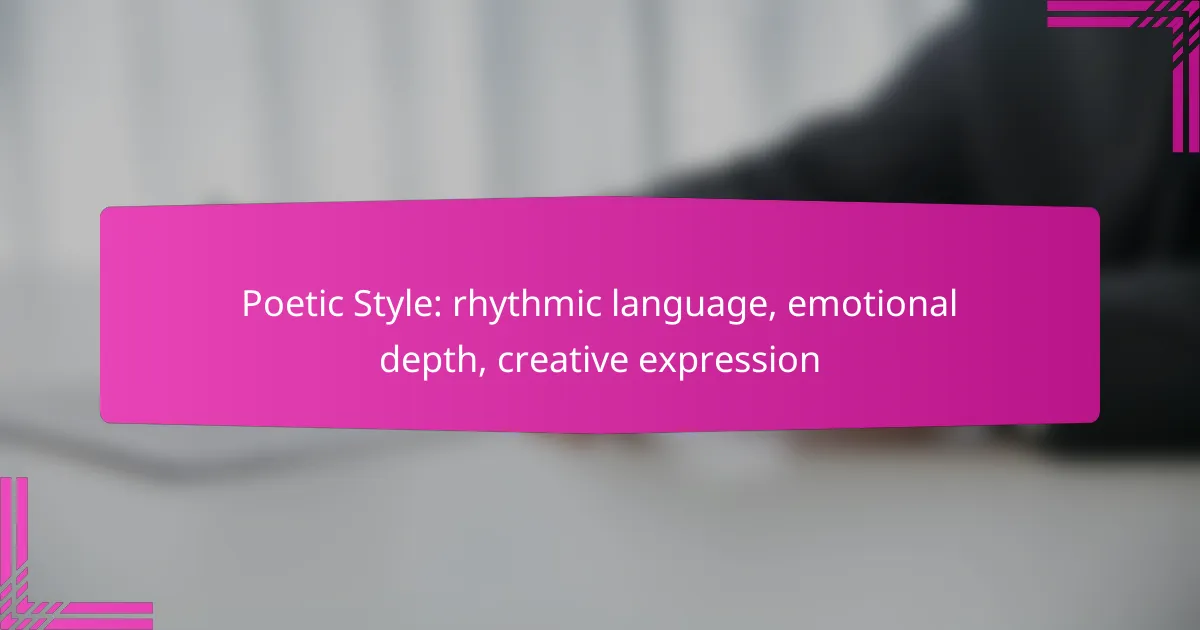Poetry thrives on rhythmic language, which not only adds a musical quality but also draws readers into a deeper emotional experience. By employing meter and rhyme, poets can convey complex feelings and meanings that resonate on a personal level. Embracing diverse experiences and experimenting with different styles enhances creative expression, allowing each poet to discover their unique voice.

How can rhythmic language enhance poetic style?
Rhythmic language enhances poetic style by creating a musical quality that engages readers and evokes emotions. It establishes patterns through meter and rhyme, allowing poets to convey deeper meanings and feelings effectively.
Use of meter and rhyme
Meter refers to the structured rhythm of a poem, while rhyme involves the repetition of similar sounds. Together, they create a predictable pattern that can make a poem more memorable and enjoyable to read. For instance, traditional forms like sonnets and limericks rely heavily on these elements to establish their unique rhythms.
When using meter, poets should consider the effect of different patterns, such as iambic pentameter, which can convey a sense of elegance and formality. Conversely, irregular meter can create tension or surprise, adding complexity to the poem’s emotional landscape.
Impact on emotional resonance
Rhythmic language significantly impacts a poem’s emotional resonance by enhancing the feelings conveyed through word choice and structure. A steady rhythm can evoke calmness, while abrupt shifts can create excitement or distress. This interplay allows poets to manipulate emotions effectively, guiding readers through the intended experience.
For example, a slow, flowing rhythm may evoke nostalgia, while a rapid, staccato rhythm can reflect urgency or chaos. Poets should experiment with different rhythms to discover how they can amplify the emotional depth of their work.
Examples from Australian poets
Australian poets like Judith Wright and Les Murray have effectively utilized rhythmic language to enhance their poetic style. Wright’s use of meter and rhyme in her nature-themed poems often reflects the beauty and complexity of the Australian landscape, drawing readers into her emotional world.
Similarly, Les Murray’s work showcases a rich interplay of rhythm and sound, often using colloquial language that resonates with Australian culture. His poems frequently explore themes of identity and belonging, with rhythmic choices that underscore the emotional weight of his subjects.

What emotional depth does poetic expression convey?
Poetic expression conveys emotional depth by using language that evokes feelings and resonates with personal experiences. Through rhythm, imagery, and metaphor, poetry captures complex emotions, allowing readers to connect with the sentiments expressed.
Exploration of personal experiences
Poetry often serves as a medium for exploring personal experiences, allowing writers to articulate their innermost thoughts and feelings. By reflecting on significant life events, poets can convey vulnerability and authenticity, drawing readers into their emotional landscape.
For instance, a poem about loss may delve into the nuances of grief, using vivid imagery to illustrate the pain of separation. This personal exploration not only fosters empathy but also encourages readers to reflect on their own experiences of love, loss, and resilience.
Connection to universal themes
In addition to personal experiences, poetry connects to universal themes that resonate across cultures and time periods. Themes such as love, nature, and mortality are often explored, highlighting shared human experiences that evoke deep emotional responses.
For example, a poem about love might capture the joy and heartache that accompany relationships, making it relatable to a wide audience. By tapping into these universal themes, poetry transcends individual narratives, creating a collective emotional experience that unites readers through shared feelings and insights.
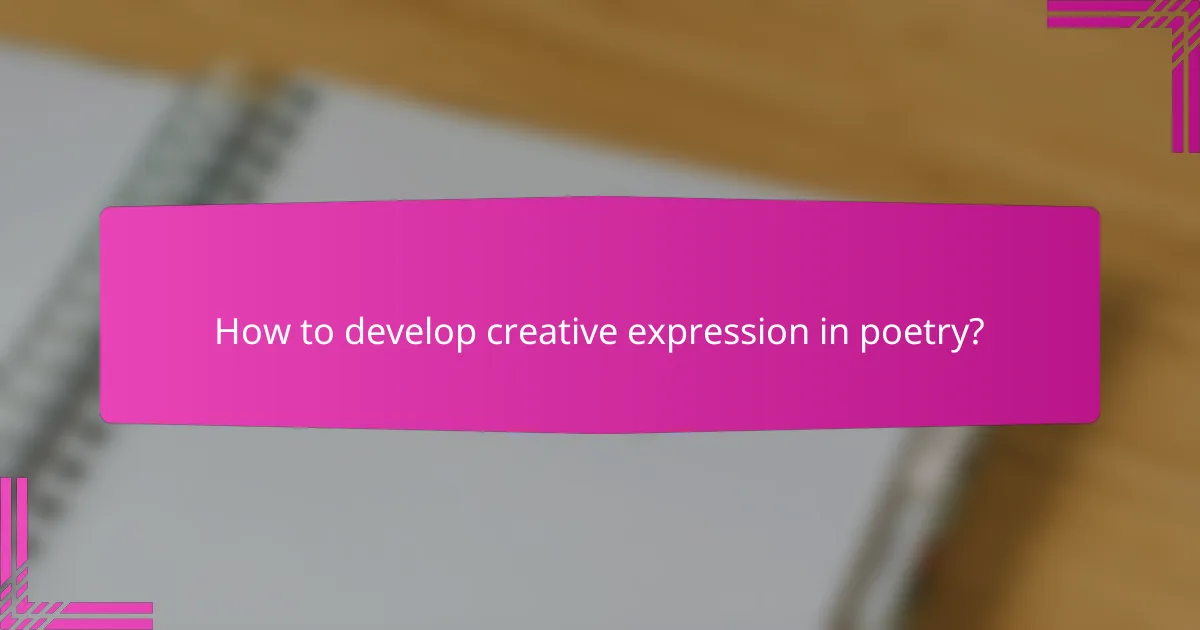
How to develop creative expression in poetry?
To develop creative expression in poetry, immerse yourself in diverse experiences and emotions, allowing them to inform your writing. Experiment with various forms, styles, and techniques to discover your unique voice and perspective.
Techniques for brainstorming ideas
Brainstorming is essential for generating fresh ideas in poetry. Start by freewriting for a set period, allowing your thoughts to flow without judgment. Consider using prompts, such as a specific word, image, or emotion, to spark inspiration.
Another effective technique is mind mapping, where you visually connect related concepts. This can help you explore themes and ideas that resonate with your experiences. Group discussions or writing workshops can also provide valuable feedback and new perspectives.
Importance of imagery and symbolism
Imagery and symbolism are crucial for creating emotional depth in poetry. Vivid imagery engages the reader’s senses, making your words come alive. Use descriptive language to paint pictures that evoke feelings and memories.
Symbolism adds layers of meaning to your work, allowing readers to interpret your poems on multiple levels. For instance, a simple object like a rose can symbolize love, beauty, or even fragility. Incorporating these elements thoughtfully can enhance the impact of your poetry and connect with your audience on a deeper level.

What are the key elements of poetic style?
Key elements of poetic style include structure and form, as well as language and diction. These components work together to create rhythm, emotional depth, and creative expression in poetry.
Structure and form
Structure and form refer to the organization of a poem, including its layout, stanza arrangement, and rhyme scheme. Common forms include sonnets, haikus, and free verse, each offering unique characteristics that influence the poem’s overall impact.
When choosing a structure, consider how it complements the poem’s theme and emotional tone. For example, a rigid form like a sonnet can convey a sense of order, while free verse allows for more fluidity and spontaneity.
Language and diction
Language and diction encompass the choice of words and the style of expression used in a poem. Poets often select words for their sound, meaning, and emotional resonance, creating layers of significance and enhancing the poem’s aesthetic quality.
To effectively use language, focus on imagery, metaphors, and similes that evoke strong feelings. Avoid clichés and strive for originality to ensure that the poem resonates with readers on a deeper level.
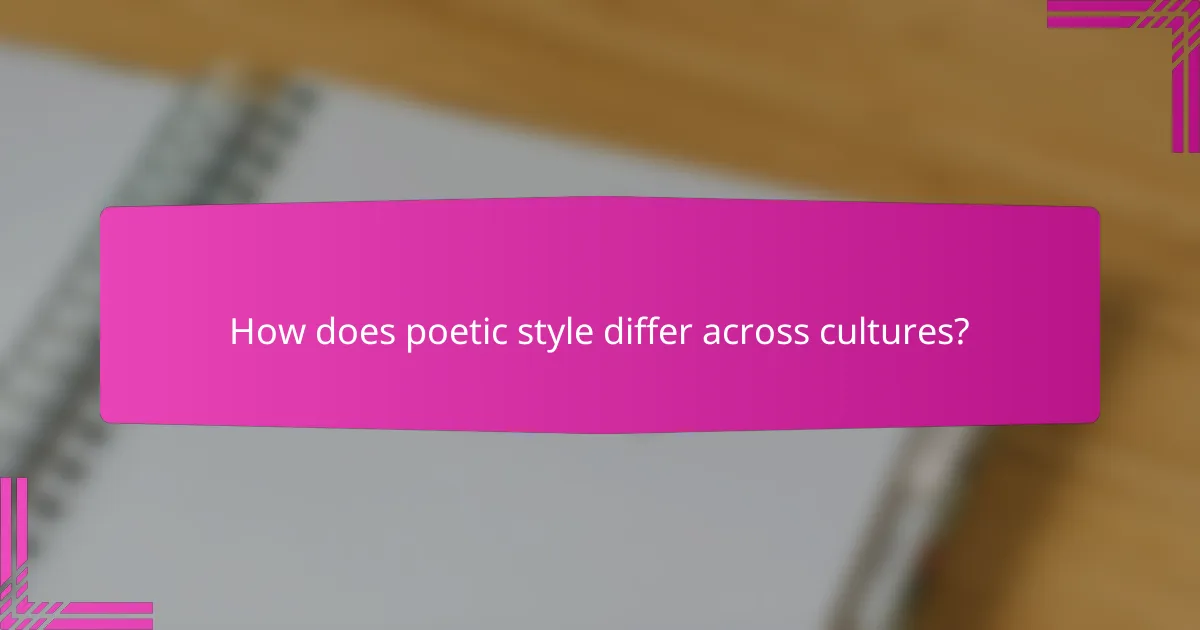
How does poetic style differ across cultures?
Poetic style varies significantly across cultures, reflecting unique historical, social, and linguistic influences. These differences manifest in rhythm, form, and thematic elements, showcasing the diverse ways emotions and experiences are expressed through language.
Comparison of Australian and British poetry
Australian poetry often emphasizes themes of nature, identity, and the landscape, reflecting the vast and varied environment of the continent. In contrast, British poetry has a long tradition that includes a wide range of styles, from the structured forms of the Romantic era to contemporary free verse, often exploring personal and societal issues.
For instance, while Australian poets like Judith Wright and Les Murray focus on the connection to land and Indigenous heritage, British poets such as Ted Hughes and Carol Ann Duffy might delve into urban life and emotional complexities. This distinction highlights how cultural context shapes poetic expression.
Influence of Indigenous Australian storytelling
Indigenous Australian storytelling plays a crucial role in shaping the poetic style within Australia, often incorporating oral traditions and Dreamtime narratives. These stories are rich in symbolism and serve to connect the community with their history and environment.
Many contemporary Australian poets draw inspiration from these Indigenous practices, blending traditional storytelling techniques with modern poetic forms. This fusion creates a unique voice that honors the past while addressing current issues, emphasizing the importance of cultural heritage in poetic expression.
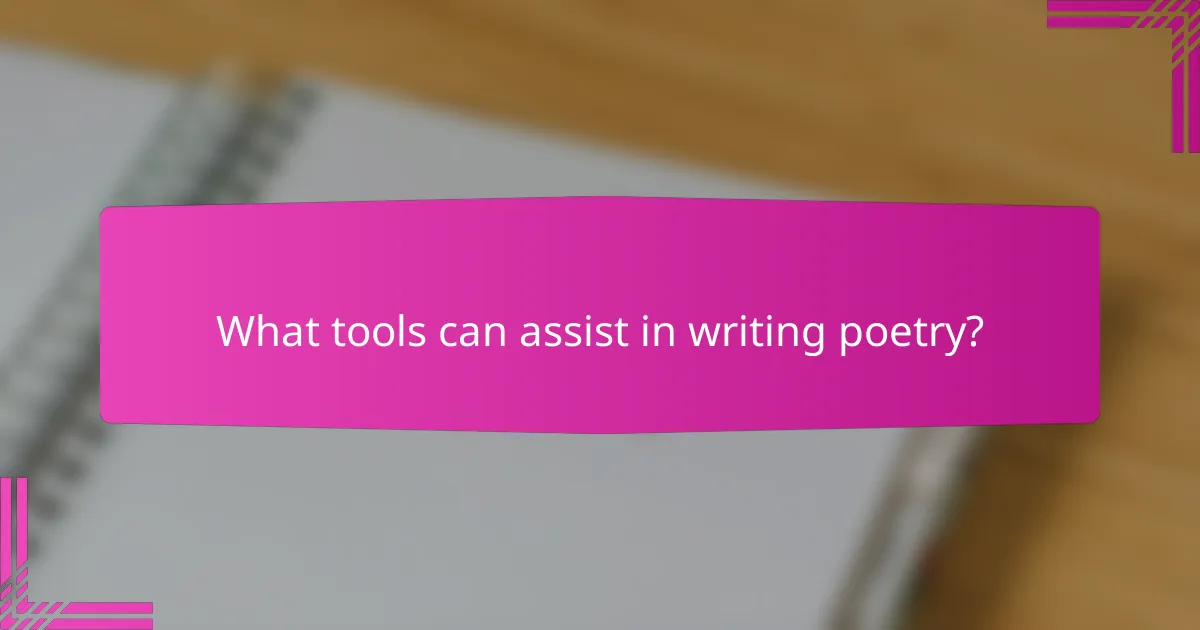
What tools can assist in writing poetry?
Various tools can enhance the poetry writing process by facilitating collaboration, improving rhyme and meter, and providing inspiration. These resources range from online platforms to mobile applications, each serving specific needs for poets at different stages of their craft.
Online platforms for collaboration
Online platforms for collaboration allow poets to connect, share, and refine their work with others. Websites like Wattpad and Scribophile enable users to post their poems and receive feedback from fellow writers, fostering a supportive community.
When choosing a platform, consider the audience and the type of feedback you seek. Some platforms focus on specific genres or styles, while others offer broader communities. Engaging actively with others can lead to valuable insights and new perspectives on your poetry.
Apps for rhyme and meter
Apps designed for rhyme and meter can significantly aid poets in crafting their verses. Tools like RhymeZone and Poetizer provide extensive databases of words, synonyms, and rhymes, making it easier to find the perfect word to fit your poem’s rhythm.
When using these apps, keep in mind the importance of natural flow. While they can suggest options, always prioritize the emotional depth and creative expression of your work. Experimenting with different combinations can lead to unexpected and powerful results.
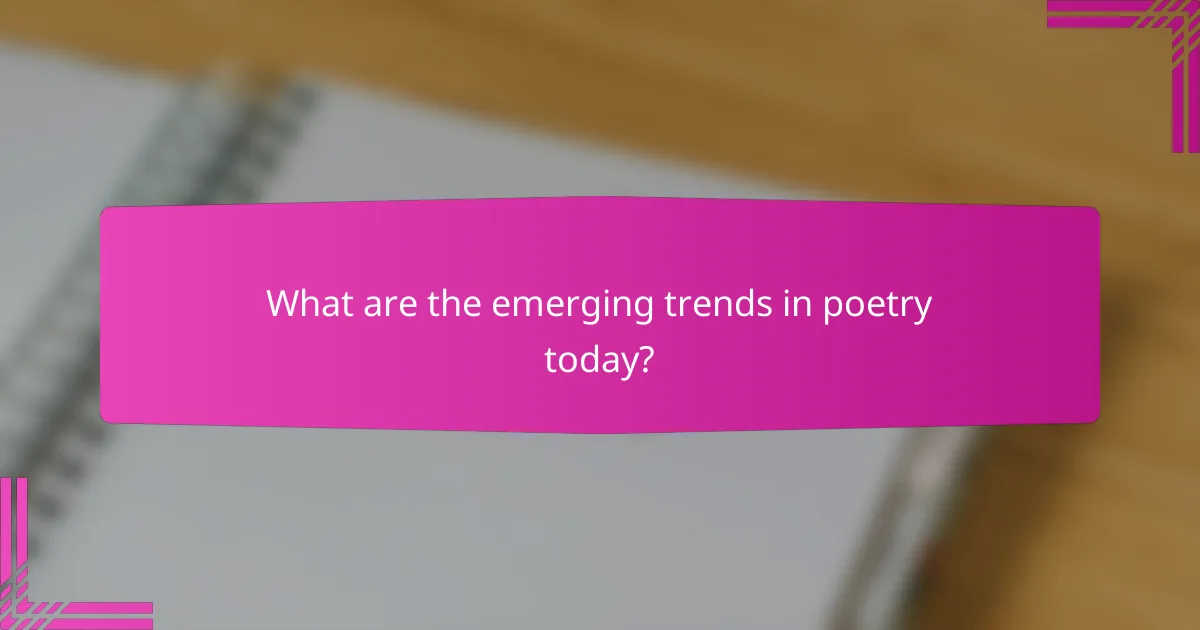
What are the emerging trends in poetry today?
Emerging trends in poetry today include a focus on accessibility, the integration of multimedia elements, and a rise in social and political themes. Poets are increasingly using digital platforms to reach wider audiences and experiment with form and content.
Accessibility and Inclusivity
Accessibility in poetry means making the art form open to diverse voices and experiences. Poets are embracing language that resonates with a broader audience, often simplifying complex themes while maintaining emotional depth. This trend encourages participation from underrepresented groups, fostering a richer poetic landscape.
Inclusivity also extends to the formats poets use. Many are turning to social media platforms like Instagram and TikTok to share their work, making poetry more relatable and engaging for younger audiences. This shift allows poets to connect with readers in real-time, breaking traditional barriers.
Multimedia Integration
Multimedia integration in poetry involves combining text with visual and auditory elements. Poets are increasingly creating video poems, audio recordings, and interactive digital experiences that enhance the reading experience. This trend allows for a more immersive engagement with the text, appealing to various senses.
For example, a poet might pair their written work with a visual slideshow or a soundscape that reflects the poem’s themes. This approach not only broadens the audience but also deepens the emotional impact of the poetry.
Social and Political Themes
Social and political themes are gaining prominence in contemporary poetry, reflecting the urgent issues of our time. Poets are using their work to address topics such as climate change, social justice, and identity politics, often drawing from personal experiences to illustrate broader societal concerns.
This trend encourages poets to engage with their communities and provoke thought and discussion. By addressing these themes, poets can inspire action and foster a sense of solidarity among readers, making poetry a powerful tool for change.
